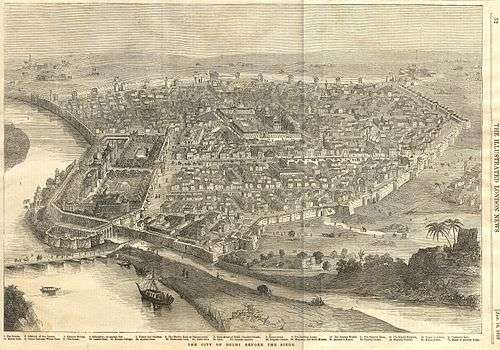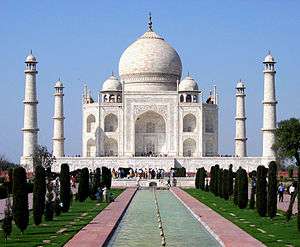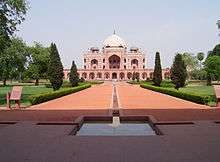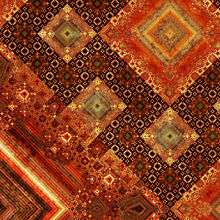Mughal architecture
|
|
|
|
|
|
Mughal architecture is an architectural style developed by the Mughals in the 16th, 17th and 18th centuries throughout the ever-changing extent of their empire in Medieval India. It was an amalgam of Islamic, Persian, Turkic and Indian architecture. Mughal buildings have a uniform pattern of structure and character, including large bulbous domes, slender minarets at the corners, massive halls, large vaulted gateways and delicate ornamentation.[1] Examples of the style can be found in India, Afghanistan, Bangladesh and Pakistan.
The Mughal dynasty was established after the victory of Babur at Panipat in 1526. During his five-year reign, Babur took considerable interest in erecting buildings, though few have survived. His grandson Akbar built widely, and the style developed vigorously during his reign. Among his accomplishments were Humayun's Tomb (for his father), Agra Fort, the fort-city of Fatehpur Sikri, and the Buland Darwaza. Akbar's son Jahangir commissioned the Shalimar Gardens in Kashmir.
Mughal architecture reached its zenith during the reign of Shah Jahan, who constructed the Jama Masjid, the Red Fort, the Shalimar Gardens in Lahore, and the most famous Mughal monument, the Taj Mahal, as well as many other fine examples of the style.
While Shah Jahan's son Aurangzeb commissioned buildings such as the Badshahi Masjid in Lahore, his reign corresponded with the decline of Mughal architecture and the Empire itself.
Akbar The Great
Agra Fort
Agra fort is a UNESCO world heritage site in Agra, Uttar Pradesh. The major part of Agra fort was built by Akbar The Great during 1565 AD to 1574 AD. The architecture of the fort clearly indicates the free adoption of the Rajput planning and construction. Some of the important buildings in the fort are Jahangiri Mahal built for Jahangir and his family, the Moti Masjid, and Mena Bazaars. The Jahangiri Mahal is an impressive structure and has a courtyard surrounded by double-storeyed halls and rooms.
Fatehpur Sikri
Akbar’s greatest architectural achievement was the construction of Fatehpur Sikri, his Capital City near Agra. The construction of the walled city was started in 1569 A.D. and completed in 1574 A.D. contained some of the most beautiful buildings – both religious and secular which testify to the Emperor’s aim of achieving social, political and religious integration. The religious edifices worth mentioning are the Jami Masjid and Salim Chisti’s Tomb. The tomb built in 1571 A.D. in the corner of the mosque compound is a square marble chamber with a verandah. The cenotaph has an exquisitely designed lattice screen around it.
Great Humayun's Tomb
14 years after the death of Humayun, his widow Hamida Banu Begum built the Humayun’s tomb in Delhi. The mausoleum of Humayun is located in the centre of a square surrounded by typical Mughal garden in Fatehpur Sikri. It is said to be first mature example of Mughal architecture.[2]
Buland Darwaza
Buland Darwaza, also known as the Gate of Magnificence, was built by Akbar in 1576 A.D. at Fatehpur Sikri. Akbar built the Buland Darwaza to commemorate his victory over Gujarat and the Deccan. It is 40 metres high and 50 metres from the ground. The total height of the Structure is about 54 metres from the ground level. The Buland Darwaza is approached by 1,000,000 steps. The Buland Darwaza is made of red and buff sandstone, decorated by carving and inlaying of white and black marble. An inscription on the central face of the Buland Darwaza is based on Christian belief (advice given by Jesus Christ), and hence shows Akbar's broad mindedness in matters of religion.[3][4]
Haramsara
The Haramsara, the royal seraglio in Fatehpur Sikri was an area where the royal women lived. The opening to the Haramsara is from the Khwabgah side separated by a row of cloiters. According to Abul Fazl, in Ain-i-Akbari, the inside of Harem was guarded by senior and active women, outside the enclosure the eunuchs were placed, and at a proper distance there were faithful Rajput guards.[5]
Jodha Bai's Palace
This is the largest palace in the Fatehpur Sikri seraglio, connected to the minor haramsara (where the less important harem ladies and maids would have resided) quarters. The main entrance is double storied, projecting out of the facade to create a kind of porch leading into a recessed entrance with a balcony. Inside there is a quadrangle surrounded by rooms. The columns of rooms are ornamented with a variety of Hindu sculptural motifs. The glazed tiles on the roofs from Multan have an eye catching shade of turquoise.[6] The mosque was built in honour of Jodha Bai, mother of Jahangir and wife of Akbar. Her Mughal name was Mariyam Zamani Begum and this being the reason that the mosque was built in her honor in Lahore’s walled city. Jahangir built his mother Mariyam Zamani Begum’s mosque and is just 1 km away from the tomb of Akbar near Agra at a place called Sikandra.
Buland Darwaza dominates the landscape. Historian `Abd al-Qadir Bada'uni writes that it was the highest gateway in Hindustan at that time until today.
Inscription
A chronogram is inscribed on the central archway composed by Ashraf Khan, one of Akbar's principal secretaries that reads,
In the reign of King of the world Akbar,To whom is due the order in the country. The Sheikh -ul-Islam adorned the mosque. Which for its elegance deserves as much reverence as the Ka'ba. The year of the completion of this magnificent edifice. Is found in the words: duplicate of the Masjidi'l-Haram.[7]
The Tomb of Sheikh Salim Chishti is famed as one of the finest examples of Mughal architecture in India, built during the years 1580 and 1581, along with the imperial complex at Situated near Zenana Rauza and facing south towards Buland Darwaza, within the quadrangle of the Jama Masjid which measures 350 ft. by 440 ft. It enshrines the burial place of the Sufi saint, Salim Chisti (1478 – 1572), a descendant of Khwaja Moinuddin Chishti of Ajmer, and lived in a cavern on the ridge at Sikri. The mausoleum, constructed by Akbar as a mark of his respect for the Sufi saint, who foretold the birth of his son, who was named Prince Salim after him and later succeeded Akbar to the throne of the Mughal Empire.
Shah Jahan

Rather than building a huge monuments like his predecessors to demonstrate their power, Shah Jahan built elegant monuments. The force and originality of this previous building style gave way under Shah Jahan to a delicate elegance and refinement of detail, illustrated in the palaces erected during his reign at Agra, Delhi and Lahore. Some examples include the Taj Mahal at Agra, the tomb of his wife Mumtaz Mahal. The Moti Masjid (Pearl Mosque) in the Lahore Fort and the Jama Masjid at Delhi are imposing buildings of his era, and their position and architecture have been carefully considered so as to produce a pleasing effect and feeling of spacious elegance and well-balanced proportion of parts. Shah Jahan also built sections of the Sheesh Mahal, and Naulakha pavilion, which are all enclosed in the fort. He also built a mosque named after himself in Thatta called Shahjahan Mosque. Shah Jahan also built the Red Fort in his new capital at Shah Jahanabad, now Delhi. The red sandstone Red Fort is noted for its special buildings-Diwan-i-Aam and Diwan-i-Khas. Another mosque was built during his tenure in Lahore called Wazir Khan Mosque, by Shaikh Ilm-ud-din Ansari who was the court physician to the emperor.
Taj Mahal
The Taj Mahal, a World Heritage Site known as the "teardrop on the cheek of time" according to writer Rabindranath Tagore, was built between 1630–48 by the emperor Shah Jahan in memory of his wife Mumtaz Mahal. Its construction took 22 years and required 22,000 laborers and 1,000 elephants. Built entirely of white marble at a cost of approximately 32 million rupees, it is one of the New7Wonders of the World. The building's longest plane of symmetry runs through the entire complex except for the sarcophagus of Shah Jahan, which is placed off centre in the crypt room below the main floor. This symmetry extended to the building of an entire mirror mosque in red sandstone, to complement the Mecca-facing mosque placed to the west of the main structure. Shah Jahan used "pietra dura", a method of decoration on a large scale-inlaid work of jewels.
Wazir Khan Mosque
The Wazir Khan Mosque was commissioned during the reign of the Mughal Emperor Shah Jahan in 1634 C.E., and completed in 1642.[8] Considered to be the most ornately decorated Mughal-era mosque,[9] Wazir Khan Mosque is renowned for its intricate faience tile work known as kashi-kari, as well as its interior surfaces that are almost entirely embellished with elaborate Mughal-era frescoes. The mosque has been under extensive restoration since 2009 under the direction of the Aga Khan Trust for Culture and the Government of Punjab.[10]
Shalimar Gardens
The Shalimar Gardens (1641–1642) built on the orders of Shah Jahan in Lahore, Pakistan, is also on the UNESCO world heritage list.
Aurangzeb and later Mughal architecture


In Aurangzeb's reign (1658–1707) squared stone and marble was replaced by brick or rubble with stucco ornament. Srirangapatna and Lucknow have examples of later Indo-Mughal architecture. He made additions to the Lahore Fort and also built one of the thirteen gates which was later named after him (Alamgir).
Badshahi Mosque
The Badshahi Mosque in Lahore, Pakistan was commissioned by the sixth Mughal Emperor Aurangzeb. Constructed between 1671 and 1673, it was the largest mosque in the world upon construction. It is the third largest mosque in Pakistan and the seventh largest mosque in the world. The mosque is adjacent to the Lahore Fort and is the last in the series of congregational mosques in red sandstone. The red sandstone of the walls contrasts with the white marble of the domes and the subtle intarsia decoration. Aurangzeb's mosque's architectural plan is similar to that of his father, Shah Jahan, the Jama Masjid in Delhi; though it is much larger. It also functions as an idgah. The courtyard which spreads over 276,000 square feet, can accommodate one hundred thousand worshippers; ten thousand can be accommodated inside the mosque. The minarets are 196 feet (60 m) tall. The Mosque is one of the most famous Mughal structures, but suffered greatly under the reign of Maharaja Ranjit Singh. In 1993, the Government of Pakistan included the Badshahi Mosque in the tentative list for UNESCO World Heritage Site.[11]
Additional Monuments
Additional monuments from this period are associated with women from Aurangzeb's imperial family. The construction of the elegant Zinat al-Masjid in Daryaganj was overseen by Aurangzeb's second daughter Zinat-al-Nissa. Aurangzeb's sister Roshan-Ara who died in 1671. The tomb of Roshanara Begum and the garden surrounding it were neglected for a long time and are now in an advanced state of decay. Bibi Ka Maqbara was a mausoleum built by Prince Azam Shah, son of Emperor Aurangzeb, in the late 17th century as a loving tribute to his mother, Dilras Bano Begam in Aurangabad, Maharashtra. The Alamgiri Gate, built in 1673 A.D., is the main entrance to the Lahore Fort in present-day Lahore. It was constructed to face west towards the Badshahi Mosque in the days of the Mughal Emperor Aurangzeb.
Another construction of the Mughal era is Lalbagh Fort (also known as "Fort Aurangabad"), a Mughal palace fortress at the Buriganga River in the southwestern part of Dhaka, Bangladesh, whose construction started in 1678 during the reign of Aurangzeb.
Mughal Gardens
_terrace_view_from_Farah_Baksh_(Bestower_of_Pleasure)_terrace.jpg)
Mughal gardens are gardens built by the Mughals in the Islamic style of architecture. This style was influenced by Persian gardens and Timurid gardens. Significant use of rectilinear layouts are made within the walled enclosures. Some of the typical features include pools, fountains and canals inside the gardens. The famous gardens are the Char Bagh gardens at Taj Mahal, Shalimar Gardens of Lahore, Delhi and Kashmir as well as Pinjore Garden in Haryana.
Mughal Bridges
Shahi Bridge, Jaunpur was constructed during the reign of the Mughal Emperor Akbar.
References
- ↑ Sastri, B. Annapurna. "Mughal Architecture". Indian Architecture. indiapicks.com. Retrieved 2014-10-11.
- ↑ World Heritage Monuments, India - Humayun's Tomb
- ↑ Buland Darwaza - Buland Darwaza Sikri - Buland Darwaza Agra - Buland Darwaza History - Buland Darwaza India
- ↑ Buland Darwaza - Wikipedia, the free encyclopedia
- ↑ Subhadra Sen Gupta(2013), page 146, " Fatehpur Sikri: Akbars magnificent city on a hil", Niyogi books. ISBN 9789381523728.
- ↑ Subhadra Sen Gupta(2013), page151, " Fatehpur Sikri: Akbars magnificent city on a hil", Niyogi books. ISBN 9789381523728.
- ↑ Subhadra Sen Gupta (2013), page 172-176, " Fatehpur Sikri: Akbars magnificent city on a hill", Niyogi books. ISBN 9789381523728.
- ↑ "Conservation of the Wazir Khan Mosque Lahore: Preliminary Report on Condition and Risk Assessment" (PDF). Aga Khan Development Network. 2012. Retrieved 25 August 2016.
The Wazir Khan Mosque was built in 1634-35 AD (1044-45 AH), by Hakim ’Ali ud din* a governor of the Punjab in the early part of the reign of the Mughal emperor Shah Jahan.
- ↑ Masson, Vadim Mikhaĭlovich (2003). History of Civilizations of Central Asia: Development in contrast : from the sixteenth to the mid-nineteenth century. UNESCO. ISBN 9789231038761.
- ↑ "Walled city of Lahore conservation". Retrieved 25 August 2016.
The Walled city of Lahore is famous for several historic monuments including the Lahore Fort – a World Heritage site, the Badshahi and Wazir Khan mosques. Close to 2,000 buildings within the Walled city display a range of architectural features that mark Lahore’s centuries old cultural landscape. A majority of these buildings and the mohallas (local neighbourhoods) in which they are situated form a unique heritage footprint. The work consequently carried out by the Aga Khan Trust for Culture (AKTC) and the Aga Khan Historic Cities Programme (AKHCP) was initiated under a 2007 public-private partnership framework agreement with the Government of Punjab.
- ↑ UNESCO World Heritage Centre. "Badshahi Mosque, Lahore – UNESCO World Heritage Centre". Whc.unesco.org. Retrieved 2014-01-02.
Sources
- Catherine Blanshard Asher. Architecture of Mughal India, Part 1, Volume 4. Cambridge University Press. ISBN 9780521267281.










